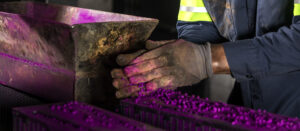
Since the introduction of the European Union directive on the Restriction of the use of certain Hazardous Substances (RoHS), keeping data centers free of harmful corrosion has become more challenging. Excessive corrosion often leads to electronics warranty non-compliance, circuit board failure, ghost signaling, and even complete failure of electronics components. Put simply, data center corrosion increases the potential for downtime and raises maintenance demands, both of which can significantly hurt the bottom line. Fortunately, while corrosion can lead to a seemingly limitless number of problems, protecting your data center is a relatively straightforward two-step process:
Monitoring
At its most basic, a corrosion monitoring system should determine the types of contaminants present in the environment and the severity of the corrosion. More advanced systems can identify sulfur dioxide, hydrogen sulfide, nitrogen oxides, and other acidic gases in real-time to identify threats before they can cause serious damage to electronics. There are two ways to go about monitoring corrosion threats: active and passive. Active monitoring – as the name would suggest – involves constant data feedback on types of corrosion, corrosion levels, temperature and humidity. Passive monitoring gathers similar data feedback, but uses a one-time coupon to accumulate data over a fixed period, typically 30 days. Because of it’s lower cost, passive monitoring is usually the first step for data center managers. Using a passive monitoring coupon, it’s easy to identify corrosion issues and formulate an attack plan. Once corrosion has been identified and the area has been scrubbed, data centers will typically move to a more expensive, real-time active monitoring solution to stay ahead of any future problems.
Filtration
Once contaminants and severity of corrosion have been identified through monitoring, the next step to protecting sensitive electronics is to filter and “scrub”. This is best accomplished through a process of filtering the air through a contaminant absorbing/neutralizing media and then providing pressurized and/or recirculated air, free of corrosive gases. Absorption media is typically composed of carbon, alumina, and other binders and can be designed to neutralize chlorine, hydrogen sulfide, and sulfur dioxide – elements most-likely to cause corrosion. This process of neutralizing and scrubbing is ideal for removing air contaminants from controlled environments containing sensitive computer electronics and electrical equipment, such as control rooms or rooms housing delicate equipment: data centers, telecommunication centers, laboratories, medical testing and treatment environments, mill control rooms, and other process industries.
Meeting Corrosion Head On
While identifying corrosion, scrubbing contaminants, and implementing a monitoring solution are the keys to protecting data centers; the first steps toward corrosion control are identifying a full-spectrum solution partner, choosing the best products for your specific application, and developing short and long-term strategies that insure data center integrity. Data center managers have a lot of options, ranging from purchasing best-of-breed standalone products, to implementing 360°, end-to-end solutions. In choosing the right strategy, it’s also important to look for a partner/vendor that has an established track record of quality, customer service, innovative R&D, and a commitment to clean air technologies.
If your research leads you to Purafil, we’d be happy to help you develop and implement a solution that not only helps you control corrosion, but that identifies problems before they start. As a world leader in innovation, design, engineering, and manufacturing of gas-phase air filtration systems, atmospheric and reactivity corrosion monitors, and UL classified granular media, we believe Purafil is always the first choice when it comes to protecting your data center investment.
Recommended Posts
Categories
Archives

As the backbone of our digital lives, data centers have always faced a suite of fundamental needs: With the rise of artificial intelligence, those needs are only becoming more essential—and more difficult to meet. AI workloads are hungry, not just for processing power, but for energy, and consequently, cooling. As heat loads rise, so does […]
Author:
Date: 2025-06-17
View More

As we embrace this new year, it’s the perfect time to assess the health of your equipment and ensure your media is performing at its best. Do you remember the last time you had a Media Life Analysis (MLA) conducted on the media in your equipment? If it’s been a while, now is the time […]
Author:
Date: 2025-02-27
View More

Purafil isn’t the only company that makes media to solve odor, corrosion, and other air quality problems, but they are often regarded as the best. In a competitive environment, what allows Purafil’s media to consistently outperform the rest? This blog explores Purafil’s unique position in the air cleaning industry and illustrates the key differences between […]
Author:
Date: 2025-01-31
View More